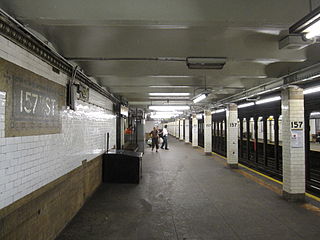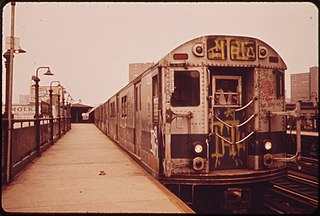
The Interborough Rapid Transit Company (IRT) was the private operator of New York City's original underground subway line that opened in 1904, as well as earlier elevated railways and additional rapid transit lines in New York City. The IRT was purchased by the city in June 1940, along with the younger BMT and IND systems, to form the modern New York City Subway. The former IRT lines are now the A Division or IRT Division of the Subway.

Redbird trains were eight New York City Subway train models so-nicknamed because of their red paint. The Redbirds totaled 1,410 cars of the following types on the A Division lines: R26, R28, R29, R33, R33S, and R36. There were also 550 cars on the B Division lines: R27 and R30/A. All were built by the American Car and Foundry Company and the St. Louis Car Company.

The R33S was a New York City Subway car that was built by St. Louis Car Company in 1963 for the IRT A Division. They were purchased for service on the IRT Flushing Line, which was the closest line to the 1964 New York World's Fair. A total of 40 cars were built, arranged as single cars. While in regular service, each R33S was coupled to five two-car consists of R36 cars to make 11-car trains for the 7 and <7> routes.
The IRT Broadway–Seventh Avenue Line is a New York City Subway line. It is one of several lines that serves the A Division, stretching from South Ferry in Lower Manhattan north to Van Cortlandt Park–242nd Street in Riverdale, Bronx. The Brooklyn Branch, known as the Wall and William Streets Branch during construction, from the main line at Chambers Street southeast through the Clark Street Tunnel to Borough Hall in Downtown Brooklyn, is also part of the Broadway–Seventh Avenue Line. The IRT Broadway–Seventh Avenue Line is the only line to have elevated stations in Manhattan, with two short stretches of elevated track at 125th Street and between Dyckman and 225th Streets.

The 125th Street station is an elevated local station on the IRT Broadway–Seventh Avenue Line of the New York City Subway. Located at the intersection of 125th Street and Broadway, at the border of the Manhattanville and Morningside Heights neighborhoods of Manhattan, it is served by the 1 train at all times.

The AB Standard was a New York City Subway car class built by the American Car and Foundry Company and Pressed Steel Car Company between 1914 and 1924. It ran under the operation of the Brooklyn Rapid Transit Company (BRT) and its successors, which included the Brooklyn–Manhattan Transit Corporation (BMT), the New York City Board of Transportation, and the New York City Transit Authority (NYCTA). The cars were designed following the signing of the Dual Contracts, which called for a major expansion of the BRT. A total of 950 cars were built.

The 157th Street station is a local station on the IRT Broadway–Seventh Avenue Line of the New York City Subway. Located at the intersection of Broadway and 157th Street in Washington Heights neighborhood of Manhattan, it is served by the 1 train at all times.

The Marble Hill–225th Street station is a local station on the IRT Broadway–Seventh Avenue Line of the New York City Subway. Located at the intersection of Broadway and 225th Street in the Marble Hill neighborhood of Manhattan, it is served by the 1 train at all times.

The 238th Street station is a local station on the IRT Broadway–Seventh Avenue Line of the New York City Subway. Located at the intersection of 238th Street and Broadway in the Kingsbridge neighborhood of the Bronx, it is served by the 1 train at all times.

The R17 was a New York City Subway car model built by the St. Louis Car Company in 1954 for the IRT A Division. A total of 400 cars were built, arranged as single units. Two versions were manufactured: Westinghouse (WH)-powered cars and General Electric (GE)-powered cars.

The R22 was a New York City Subway car built by the St. Louis Car Company from 1957 to 1958. The cars were a "follow-up" or supplemental stock for the A Division's R21s and closely resemble them. A total of 450 cars were built, arranged as single units. Two versions were manufactured: Westinghouse (WH)-powered cars and General Electric (GE)-powered cars.

The Composite was a New York City Subway car class built from 1903 to 1904 by the Jewett, St. Louis, Wason, and John Stephenson companies for the Interborough Rapid Transit Company and its successor, the New York City Board of Transportation.

The Hedley Hi-V was a New York City Subway car class built from 1910 to 1911, which were motor cars, and then in 1915 an order for trailers that were numbered 4223–4514. All were built by the American Car and Foundry, Standard Steel Car Company, Pressed Steel Car Company, and Pullman Company. These were the first cars built with center doors. They were also the last high voltage cars built for the system because high voltage cars were a hazard to both the train operators and track crews. Thus, all subway cars delivered afterward were low voltage cars.

The Deck Roof Hi-V was a New York City Subway car class built from 1907 to 1908 by the American Car and Foundry for the IRT and its successors, the New York City Board of Transportation and the New York City Transit Authority.

The Steinway Lo-V was a New York City Subway car type built from 1915 to 1925 by the Pressed Steel Car Company, American Car and Foundry, and Pullman Company. These cars were built specifically for use on the IRT Corona Line, and the IRT Astoria Line. They had special gear ratios to climb the steep grades (4.5%) in the Steinway Tunnels, something standard IRT equipment could not do.

The Standard Lo-V was a New York City Subway car type built from 1916 to 1925 by the Pressed Steel Car Company, American Car and Foundry, and Pullman Company for the IRT. A total of 1,020 cars were built, which consisted of 725 motors and 295 trailers. It was the third and most common "Lo-V" type car ordered for the IRT.

The first regularly operated line of the New York City Subway was opened on October 27, 1904, and was operated by the Interborough Rapid Transit Company (IRT). The early IRT system consisted of a single trunk line running south from 96th Street in Manhattan, with a southern branch to Brooklyn. North of 96th Street, the line had three northern branches in Upper Manhattan and the Bronx. The system had four tracks between Brooklyn Bridge–City Hall and 96th Street, allowing for local and express service. The original line and early extensions consisted of:

The Flivver Lo-V was a New York City Subway car type built in 1915 by the Pullman Company for the IRT and its successors, which included the New York City Board of Transportation and the New York City Transit Authority. The name Flivver originates from a slang term of the same name used during the early part of the 20th century to refer to any small car that gave a rough ride.

The MUDC was a series of New York City Subway cars originally built by the St. Louis, Wason, Jewett, Cincinnati, and Barney and Smith companies, and rebuilt by the Interborough Rapid Transit Company in 1923–1924 from former Manhattan El gate cars.

Manhattan El is a term used to describe Interborough Rapid Transit Company (RT) elevated gate cars used on predecessor lines of the New York City Subway system. These cars were built by the Pullman, Wason, Gilbert & Bush, Bowers & Dure, Barney & Smith, Jewett, St. Louis, Cincinnati, and American Car and Foundry companies.


















